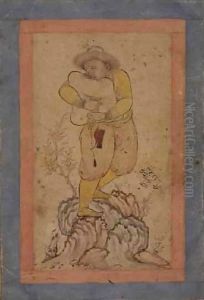Riza-i Abbasi Paintings
Riza-i Abbasi, also known as Reza Abbasi, was one of the most renowned Persian painters and calligraphers of the Safavid era, flourishing during the reign of Shah Abbas I. He was born in Kashan, Iran, around 1565 and is believed to have died in Isfahan in 1635. His father, Ali Asghar, was also an artist, which likely influenced Riza's early development and education in the arts.
Riza moved to the Safavid capital, Isfahan, where he received patronage from Shah Abbas I, who was a great supporter of the arts and tasked with establishing Isfahan as a cultural and economic center of Persia. Riza quickly rose to prominence and eventually became the head of the royal atelier. Under his leadership, the atelier produced numerous works of art, including manuscripts, single-page paintings, and ornamental design.
Riza's work is characterized by its innovative compositions, elegant figures, and dynamic use of line. He was particularly adept at portraying intimate scenes that often contained figures in private, reflective moments, a significant departure from the traditional grandiose and public depictions of figures in Persian art. His style played a crucial role in the development of the Safavid art school and had a lasting influence on Persian painting.
He is best known for his mastery in drawing and his significant contribution to the evolution of the Safavid style, which combined Persian and European techniques and ideas. His work not only reflects the cultural changes occurring in Persia during this period but also the personal taste and artistic interests of Shah Abbas, who sought to modernize and elevate Persian art.
Riza-i Abbasi's legacy is preserved in many collections including the Metropolitan Museum of Art, the British Museum, and the Louvre, which house some of his finest works. His influence extended beyond his lifetime and geography, affecting the arts of the Ottoman Empire and Mughal India, and he is remembered as one of the most significant figures in the history of Persian art.
